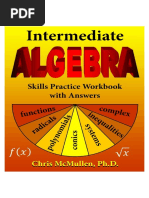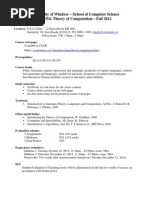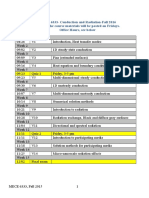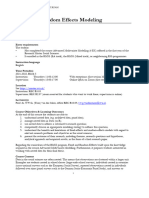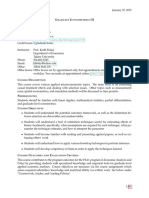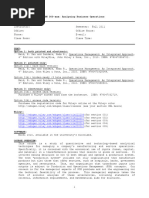Syllabus 211 Fall 2014
Uploaded by
Saad AnisSyllabus 211 Fall 2014
Uploaded by
Saad AnisSyllabus of Calc. III MATH 211 L02, Fall 2014, Dr M.
Salman
QATAR UNIVERSITY
DEPT OF MATH, STAT & PHYS
SYLLABUS OF MATH 211, FALL 2014
Course Information
1. Calculus III - 11482 - MATH 211 - L02
8:00 am - 9:15 am
MW Business & Economics Building D204
2:00 pm - 3:20 pm
W
Business & Economics Building D203
2. Calculus III - 18229 - MATH 211 - L04
11:00 am - 12:50 pm TR
Business & Economics Building D205
Instructor Information
Name: Dr Mohamed Salman
Office Location: Corridor 4; D207
Telephone Number: 4403-4618
Email Address: msalman@qu.edu.qa
Office Hours
Sun 1:00 2:00
Wed 9:30 12:30,
or by appointment.
Textbook: Calculus, by J. Stewart, 7th Edition.
Exams & Grades:
There will be three major exams:
1. First Exam: 25%, Saturday Nov 1, 2014 at 8:00 -10:00 AM, Alkindi Hall.
2. Second Exam: 25%, Saturday Dec 6, 2014 at 8:00 -10:00 AM, Alkindi Hall.
3. Quizzes (in class): 10%
4. Homework assignments: 5%
5. Final Exam: 35%, Thursday January 8, 2015 at 14:00 16:00.
Grades for the course will be assigned as follows:
Percent grade
90 -100
85 - 89
80 84
75 -79
70 74
65 - 69
60 - 64
below 60
Letter grade
Earned Points
A
4.0
B+
3.5
B
3.0
C+
2.5
C
2.0
D+
1.5
D
1.0
F
0.0
Course Description
CH 12. VECTORS AND THE GEOMETRY OF SPACE.
Three-Dimensional Coordinate Systems. Vectors. The Dot Product. The Cross
Product. Equations of Lines and Planes. Cylinders and Quadric Surfaces.
CH 13. VECTOR FUNCTIONS.
Page 1 of 5
Syllabus of Calc. III MATH 211 L02, Fall 2014, Dr M. Salman
Vector Functions and Space Curves. Derivatives and Integrals of Vector Functions. Arc Length
and Curvature.
CH 14. PARTIAL DERIVATIVES.
Functions of Several Variables. Limits and Continuity. Partial Derivatives. Tangent Planes and
Linear Approximations. The Chain Rule. Directional Derivatives and the Gradient Vector.
Maximum and Minimum Values. Lagrange Multipliers.
CH 15. MULTIPLE INTEGRALS.
Double Integrals over Rectangles. Iterated Integrals. Double Integrals over General Regions.
Double Integrals in Polar Coordinates. Applications of Double Integrals. Triple Integrals. Triple
Integrals in Cylindrical. Triple Integrals in Spherical Coordinates. Change of Variables in
Multiple Integrals.
Course Objectives
The course aims at:
1. Developing the notion of vectors and their properties in the three-dimensional space.
2. Presenting the calculus of vector functions and curves.
3. Developing the ability to differentiate functions of several variables to solve practical problems.
4. Providing students with the skills of multiple integration for function of several variables and its
application to practical problems
Learning Outcomes
By the end of the course, the students should be able to:
1. Do operations on vectors.
2. Identify different types of equations of lines, planes and surfaces.
3. Recognize different types of calculus operations of vector-valued functions.
4. Find arc length, unit tangent and normal vectors.
5. Identify the basic properties of the real-valued functions of several variables.
6. Evaluate limits of functions, and discuss their continuity and partial derivatives.
7. Find directional derivatives and gradients and their properties.
8. Solve optimization problems involving two or three variables.
9. Evaluate multiple integrals in different types of coordinates systems.
10. Evaluating line and surface integrals.
Delivery Methods
We will use different types of teaching methods including:
Presentation explaining material.
Problem solving.
Discussion - actively involving students in learning by asking questions that provoke thinking and verbal
response.
Using Math packages explaining some material.
The lecture will be posted on the e-learning tool Blackboard, so pay you attention to the class and try to
understand everything.
Learning Resources & Media
Data show will be used also to visualize some important graphs in the three dimension space
Page 2 of 5
Syllabus of Calc. III MATH 211 L02, Fall 2014, Dr M. Salman
We will use some graphing softwares and some Java Applets to help students visualize graphs.
Blackboard will be used frequently: http://mybb.qu.edu.qa/
Weekly Plan
Week
1
Date
Sep 14 18
Sep 21 25
Sep 28 Oct 2
Oct 12 16
Oct 19 23
Oct 26 30
Topics
12.1 Three-Dimensional Coordinate systems
12.2 Vectors
12.3 The Dot Product, projections
12.4 The Cross Product
12.5 Equations of Lines and Planes
12.6 Cylinders and Quadric Surfaces
Eid Aladha Break Oct 3 through Oct 11.
13.1 Vector Functions and Space Curves
13.2 Derivative and Integrals of vector functions
13.3 Arc Length and Curvature
14.1 Functions of Several Variables
14.2 Limits and Continuity
14.3 Partial Derivatives
First Exam: Sat Nov 1, 2014 at 8:00-10:00 AM.
14.4 Tangent Planes and Linear Approximations
14.5 The Chain Rule
14.6 Directional Derivatives and the Gradient Vector
14.7 Maximum and Minimum Values
14.8 Lagrange Multipliers
15.1 Double Integrals over Rectangles
15.2 Iterated Integrals
Nov 2 6
Nov 9 13
Nov 16 20
10
Nov 23 27
11
Nov 30 Dec 4 15.3 Double Integrals over General Regions
Second Exam: Sat Dec 6, 2014 at 8:00-10:00 AM.
12
Dec 7 11
15.4 Double Integrals in Polar Coordinates
13
Dec 14 18
15.6 Triple Integrals
14
Dec 21 25
15.7 Triple Integrals in Cylindrical Coordinates
15
Dec 28 Jan 1
15.8 Triple Integrals in Spherical Coordinates
15.9 Change of Variables
Final Exam: Thursday January 8, 2015 at 14:00 16:00.
Learning Activities and Tasks
Students should be held responsible for their own ongoing learning process. They need to do their assignments
independently unless they are allowed to work in groups.
Course Regulations
Student Responsibilities and Attendance Policies and Procedures
Class attendance is compulsory. In accordance with University regulations, a students absence cannot
exceed 25% of the total number (entire semester) of class meetings. If your absence rate exceeds 25%,
Page 3 of 5
Syllabus of Calc. III MATH 211 L02, Fall 2014, Dr M. Salman
including both excused and unexcused absences, you will NOT be allowed to take the final examination
and will receive an F barred grade for the course.
Students are expected to be punctual (every 3 late class arrivals will be counted as 1 class absence) in
class attendance and to conduct themselves in an adult and professional manner.
Homework assignments and library assignment should be worked independently. Exchanging ideas are
permitted orally but don't require any kind of copying.
Homework assignment should be submitted in organized way and any late assignments may be assessed
and corrected but the grade will be zero.
Plagiarism (Academic Dishonesty)
All students are expected to turn in work that is their own. Any attempt to pass off another's work as
your own will constitute an "F" in the entire course.
Using part of, or the entire work, prepared by another or turning in a homework assignment prepared by
another student or party are examples of plagiarism.
You may discuss assignments and projects with each other, but you should do the work yourself. In the
case of group projects, you will be expected to do your share of the work. If you use someone else's
words or ideas, you must cite your sources.
Plagiarism is considered a serious academic offence and can result in your work losing marks or being failed.
QU expects its students to adopt and abide by the highest standards of conduct in their interaction with their
professors, peers, and the wider University community. As such, a student is expected not to engage in
behaviours that compromise his/her own integrity as well as that of QU. You may discuss assignments and
projects with each other, but you should do the work yourself. In the case of group projects, you will be
expected to do your share of the work. If you use someone else's words or ideas, you must cite your sources.
Plagiarism includes the following examples and it applies to all student assignments or submitted work:
Use of the work, ideas, images or words of someone else without his/her permission.
Use of someone else's wording, name, phrase, sentence, paragraph or essay without using
quotation marks.
Misrepresentation of the sources that were used.
For further information see: http://www.plagiarism.org/
Classroom Discipline
The use of mobile telephones inside the classroom is NOT allowed.
Any student disciplinary issues, which may arise, will be referred to the head of the Department.
References:
Calculus by H. Anton, I. Bivens and S. Davis, 8th Edition, 2005, Wiley .
Calculus with Analytic Geometry, by H. Edwards and D. E. Penny, 5th Edition, 1998, Prentice Hall.
Calculus, by R.T. Smith and R.B. Minton, 2nd Edition, 2002, McGraw-Hill.
Calculus: One and Several Variables by S. L. Salas, G. J. Etgen and E. Hille; 10th Edition, 2007,
Wiley.
Page 4 of 5
Syllabus of Calc. III MATH 211 L02, Fall 2014, Dr M. Salman
Additional Sources
Online Sources
Course notes will be posted on the blackboard system: http://mybb.qu.edu.qa/
MIT open course ware http://ocw.mit.edu/courses/mathematics
Recommended Problems
The following problems are meant for practice. They show the type of the problems you will encounter in this
course. You are strongly urged to solve as many problems as you can.
12.1: 131 odd, 33,34,36,38,39,40
12.2: 127 odd.
12.3: 1,3,5,6,9,13,18,19,23,25,26,27,28,43,45,47
12.4: 1,3,937 odd,38
12.5: 147 odd, 48,5160 od67,68,71,72
12.6: 1,3,4,21,23,25,27,28, 41,42
13.1: 1-28(odd); 35-38
13.2: 3-25(odd);30, 31, 32, 35-42.
13.3: 1-6; 13,14, 17-25(odd, 47,48
14.1: 9-31(odd).
14.2: 15-22,56,26, 29-44.
14.3: 15-69(odd),75-82,99-101.
14.4: 1-6,46
14.5: 1-11(odd), 21-33(odd),48-51
14.6: 4-29(odd),49-57,60,61,63,64
14.7: 5-20(odd),29-36,39-46
14.8: 3-21(odd)
15.2: 1-22,3738,
15.3: 1-22,49-54,57-58
15.4: 7-13 (odd), 19 27 (odd),29-32
15.6: 3 12
15.7: 1, 3, 9, 11, 15, 17, 21, 23, 27, 35-36
Page 5 of 5
You might also like
- The Art of Problem Solving Intermediate Algebra96% (25)The Art of Problem Solving Intermediate Algebra720 pages
- Beginner's Step-By-Step Coding Course Learn Computer Programming The Easy Way, UK Edition98% (46)Beginner's Step-By-Step Coding Course Learn Computer Programming The Easy Way, UK Edition360 pages
- The Motivational Interviewing Workbook - Exercises To Decide What You Want and How To Get There100% (10)The Motivational Interviewing Workbook - Exercises To Decide What You Want and How To Get There224 pages
- Golf Strategies - Dave Pelz's Short Game Bible PDF92% (24)Golf Strategies - Dave Pelz's Short Game Bible PDF444 pages
- Catherine V Holmes - How To Draw Cool Stuff, A Drawing Guide For Teachers and Students97% (35)Catherine V Holmes - How To Draw Cool Stuff, A Drawing Guide For Teachers and Students260 pages
- [Algebra Essentials Practice Workbook with Answers Linear and Quadratic Equations Cross Multiplying and Systems of Equations Improve your Math Fluency Series] Chris McMullen - Algebra Essentials Practice Workbook with A.pdf80% (10)[Algebra Essentials Practice Workbook with Answers Linear and Quadratic Equations Cross Multiplying and Systems of Equations Improve your Math Fluency Series] Chris McMullen - Algebra Essentials Practice Workbook with A.pdf207 pages
- Math 87 Mathematics 8 - 7 Textbook An Incremental Development Stephen Hake John Saxon100% (10)Math 87 Mathematics 8 - 7 Textbook An Incremental Development Stephen Hake John Saxon696 pages
- Self-System Therapy For Depression Client Workbook100% (8)Self-System Therapy For Depression Client Workbook113 pages
- The Science Teacher's Toolbox: Hundreds of Practical Ideas to Support Your StudentsFrom EverandThe Science Teacher's Toolbox: Hundreds of Practical Ideas to Support Your StudentsNo ratings yet
- Chris McMullen - Intermediate Algebra Skills Practice Workbook With Answers - Functions, Radicals, Polynomials, Conics, Systems, Inequalities, and (2021, Zishka Publishing) - Libgen - Li100% (3)Chris McMullen - Intermediate Algebra Skills Practice Workbook With Answers - Functions, Radicals, Polynomials, Conics, Systems, Inequalities, and (2021, Zishka Publishing) - Libgen - Li502 pages
- Module in ES 212 Engineering Mechanics Version 2No ratings yetModule in ES 212 Engineering Mechanics Version 2125 pages
- Introduction To Management Science 164.215 Course Outline: ObjectivesNo ratings yetIntroduction To Management Science 164.215 Course Outline: Objectives4 pages
- Webassign Access Code: Optional RequiredNo ratings yetWebassign Access Code: Optional Required8 pages
- Faculty of Science School of Mathematics and Statistics: MATH3121 Mathematical Methods & Partial Differential EquationsNo ratings yetFaculty of Science School of Mathematics and Statistics: MATH3121 Mathematical Methods & Partial Differential Equations8 pages
- Multivariate Analysis I: Decarlo@tc - EduNo ratings yetMultivariate Analysis I: Decarlo@tc - Edu2 pages
- Harare Institute of Technology Hit 223: Engineering Mathematics IiiNo ratings yetHarare Institute of Technology Hit 223: Engineering Mathematics Iii4 pages
- Eled 3310 Syllabus Fall 2012 With Matrix Revised 08-7-12No ratings yetEled 3310 Syllabus Fall 2012 With Matrix Revised 08-7-128 pages
- Lamar University: Department of MathematicsNo ratings yetLamar University: Department of Mathematics4 pages
- Finlay Econ 7175 Syllabus Graduate AppliedNo ratings yetFinlay Econ 7175 Syllabus Graduate Applied41 pages
- Student Version - CourseDescription Document - CSF206No ratings yetStudent Version - CourseDescription Document - CSF2065 pages
- World History and Geography 9 - SyllabusNo ratings yetWorld History and Geography 9 - Syllabus4 pages
- Ten Worst Teaching Mistakes (Continued) : Mistake #4. Give Tests That Are Too LongNo ratings yetTen Worst Teaching Mistakes (Continued) : Mistake #4. Give Tests That Are Too Long4 pages
- The Effects of Problem Based Approach On Student's Conceptual Understanding in A University Mathematics ClassroomNo ratings yetThe Effects of Problem Based Approach On Student's Conceptual Understanding in A University Mathematics Classroom4 pages
- Faculty of Business and Accountancy University Malaya: CMGB 6103 Research Methods in BusinessNo ratings yetFaculty of Business and Accountancy University Malaya: CMGB 6103 Research Methods in Business5 pages
- Spring 2017 ME 523: Numerical Solutions Applied To Heat Transfer and Fluid MechanicsNo ratings yetSpring 2017 ME 523: Numerical Solutions Applied To Heat Transfer and Fluid Mechanics5 pages
- UT Dallas Syllabus For Socs3405.501.11s Taught by Heja Kim (Heja)No ratings yetUT Dallas Syllabus For Socs3405.501.11s Taught by Heja Kim (Heja)6 pages
- UT Dallas Syllabus For Rhet1302.0s2.07u Taught by Fariborz Hadjebian (fxh037000)No ratings yetUT Dallas Syllabus For Rhet1302.0s2.07u Taught by Fariborz Hadjebian (fxh037000)11 pages
- Bus 251 Course Outline Business CommunicationNo ratings yetBus 251 Course Outline Business Communication4 pages
- Motivating for STEM Success: A 50-step guide to motivating Middle and High School students for STEM success.From EverandMotivating for STEM Success: A 50-step guide to motivating Middle and High School students for STEM success.No ratings yet
- Arena Basics: Arena Is A True Windows ApplicationNo ratings yetArena Basics: Arena Is A True Windows Application27 pages
- 2013-9-30-Chemical Engineering Road Map 2013 PDFNo ratings yet2013-9-30-Chemical Engineering Road Map 2013 PDF1 page
- Project: Guidelines & Instructions: College of Arts & Sciences Department of Chemistry & Earth SciencesNo ratings yetProject: Guidelines & Instructions: College of Arts & Sciences Department of Chemistry & Earth Sciences1 page
- Chart Title: 40.000 45.000 F (X) 23.1572162076x + 0.0227231781 R 0.9926136441 Column F Linear (Column F)No ratings yetChart Title: 40.000 45.000 F (X) 23.1572162076x + 0.0227231781 R 0.9926136441 Column F Linear (Column F)3 pages
- Gases: Short Range, Important at Longer Range, Important atNo ratings yetGases: Short Range, Important at Longer Range, Important at10 pages
- Florida Teacher Certificate Examinations (FTCE) Study Guide0% (2)Florida Teacher Certificate Examinations (FTCE) Study Guide20 pages
- Density, Relative Density and API Gravity: According To IP559 and ASTM D7777No ratings yetDensity, Relative Density and API Gravity: According To IP559 and ASTM D77771 page
- Abacus Academy of Kerala: Application FormNo ratings yetAbacus Academy of Kerala: Application Form1 page
- EMV of ALTERNATIVES - Final RequirementNo ratings yetEMV of ALTERNATIVES - Final Requirement28 pages
- Bidirectional power flow in an electric vehicle using predictive control algorithm including sneak circuit analysisNo ratings yetBidirectional power flow in an electric vehicle using predictive control algorithm including sneak circuit analysis12 pages
- Automatic Transmission / Trans: PreparationNo ratings yetAutomatic Transmission / Trans: Preparation2 pages
- MHT Cet Chemistry Triumph STD 11th and 12th MCQ Hints156155340050% (2)MHT Cet Chemistry Triumph STD 11th and 12th MCQ Hints1561553400326 pages
- Unit 2 Register Transfer and MicrooperationsNo ratings yetUnit 2 Register Transfer and Microoperations39 pages
- Over Head Transmission Line Fault Detection100% (1)Over Head Transmission Line Fault Detection9 pages
- L3 - Representing Instructions in The ComputerNo ratings yetL3 - Representing Instructions in The Computer13 pages
- Beginner's Step-By-Step Coding Course Learn Computer Programming The Easy Way, UK EditionBeginner's Step-By-Step Coding Course Learn Computer Programming The Easy Way, UK Edition
- The Motivational Interviewing Workbook - Exercises To Decide What You Want and How To Get ThereThe Motivational Interviewing Workbook - Exercises To Decide What You Want and How To Get There
- Golf Strategies - Dave Pelz's Short Game Bible PDFGolf Strategies - Dave Pelz's Short Game Bible PDF
- Catherine V Holmes - How To Draw Cool Stuff, A Drawing Guide For Teachers and StudentsCatherine V Holmes - How To Draw Cool Stuff, A Drawing Guide For Teachers and Students
- [Algebra Essentials Practice Workbook with Answers Linear and Quadratic Equations Cross Multiplying and Systems of Equations Improve your Math Fluency Series] Chris McMullen - Algebra Essentials Practice Workbook with A.pdf[Algebra Essentials Practice Workbook with Answers Linear and Quadratic Equations Cross Multiplying and Systems of Equations Improve your Math Fluency Series] Chris McMullen - Algebra Essentials Practice Workbook with A.pdf
- Math 87 Mathematics 8 - 7 Textbook An Incremental Development Stephen Hake John SaxonMath 87 Mathematics 8 - 7 Textbook An Incremental Development Stephen Hake John Saxon
- Self-System Therapy For Depression Client WorkbookSelf-System Therapy For Depression Client Workbook
- The Science Teacher's Toolbox: Hundreds of Practical Ideas to Support Your StudentsFrom EverandThe Science Teacher's Toolbox: Hundreds of Practical Ideas to Support Your Students
- Chris McMullen - Intermediate Algebra Skills Practice Workbook With Answers - Functions, Radicals, Polynomials, Conics, Systems, Inequalities, and (2021, Zishka Publishing) - Libgen - LiChris McMullen - Intermediate Algebra Skills Practice Workbook With Answers - Functions, Radicals, Polynomials, Conics, Systems, Inequalities, and (2021, Zishka Publishing) - Libgen - Li
- Introduction To Management Science 164.215 Course Outline: ObjectivesIntroduction To Management Science 164.215 Course Outline: Objectives
- Faculty of Science School of Mathematics and Statistics: MATH3121 Mathematical Methods & Partial Differential EquationsFaculty of Science School of Mathematics and Statistics: MATH3121 Mathematical Methods & Partial Differential Equations
- Harare Institute of Technology Hit 223: Engineering Mathematics IiiHarare Institute of Technology Hit 223: Engineering Mathematics Iii
- Eled 3310 Syllabus Fall 2012 With Matrix Revised 08-7-12Eled 3310 Syllabus Fall 2012 With Matrix Revised 08-7-12
- Student Version - CourseDescription Document - CSF206Student Version - CourseDescription Document - CSF206
- Ten Worst Teaching Mistakes (Continued) : Mistake #4. Give Tests That Are Too LongTen Worst Teaching Mistakes (Continued) : Mistake #4. Give Tests That Are Too Long
- The Effects of Problem Based Approach On Student's Conceptual Understanding in A University Mathematics ClassroomThe Effects of Problem Based Approach On Student's Conceptual Understanding in A University Mathematics Classroom
- Faculty of Business and Accountancy University Malaya: CMGB 6103 Research Methods in BusinessFaculty of Business and Accountancy University Malaya: CMGB 6103 Research Methods in Business
- Spring 2017 ME 523: Numerical Solutions Applied To Heat Transfer and Fluid MechanicsSpring 2017 ME 523: Numerical Solutions Applied To Heat Transfer and Fluid Mechanics
- UT Dallas Syllabus For Socs3405.501.11s Taught by Heja Kim (Heja)UT Dallas Syllabus For Socs3405.501.11s Taught by Heja Kim (Heja)
- UT Dallas Syllabus For Rhet1302.0s2.07u Taught by Fariborz Hadjebian (fxh037000)UT Dallas Syllabus For Rhet1302.0s2.07u Taught by Fariborz Hadjebian (fxh037000)
- Motivating for STEM Success: A 50-step guide to motivating Middle and High School students for STEM success.From EverandMotivating for STEM Success: A 50-step guide to motivating Middle and High School students for STEM success.
- Project: Guidelines & Instructions: College of Arts & Sciences Department of Chemistry & Earth SciencesProject: Guidelines & Instructions: College of Arts & Sciences Department of Chemistry & Earth Sciences
- Chart Title: 40.000 45.000 F (X) 23.1572162076x + 0.0227231781 R 0.9926136441 Column F Linear (Column F)Chart Title: 40.000 45.000 F (X) 23.1572162076x + 0.0227231781 R 0.9926136441 Column F Linear (Column F)
- Gases: Short Range, Important at Longer Range, Important atGases: Short Range, Important at Longer Range, Important at
- Florida Teacher Certificate Examinations (FTCE) Study GuideFlorida Teacher Certificate Examinations (FTCE) Study Guide
- Density, Relative Density and API Gravity: According To IP559 and ASTM D7777Density, Relative Density and API Gravity: According To IP559 and ASTM D7777
- Bidirectional power flow in an electric vehicle using predictive control algorithm including sneak circuit analysisBidirectional power flow in an electric vehicle using predictive control algorithm including sneak circuit analysis
- MHT Cet Chemistry Triumph STD 11th and 12th MCQ Hints1561553400MHT Cet Chemistry Triumph STD 11th and 12th MCQ Hints1561553400























